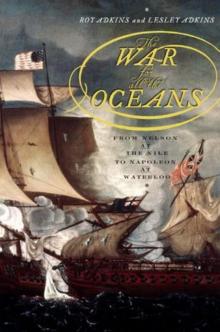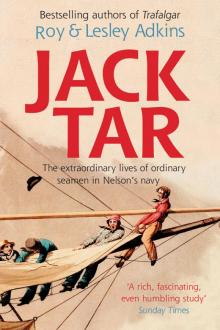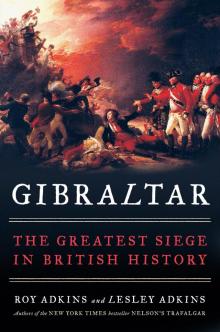- Home
- Roy Adkins
Jack Tar
Jack Tar Read online
Roy and Lesley Adkins are authors of sixteen widely acclaimed books on history and archaeology, including The War for All the Oceans, Trafalgar, Empires of the Plain and The Keys of Egypt. So far, their books have been translated into sixteen languages. They live near Exeter in Devon.
For more information, visit www.adkinshistory.com
‘Gritty detail springs from Jack Tar … Roy and Lesley Adkins have allowed the salts of Trafalgar to tell their stories in their own words’ The Times
‘A full account of life on the lower decks in the late eighteenth- and early nineteenth-century navy … Roy and Lesley Adkins bring their world alive …The material is so rich that this is a fascinating, even occasionally humbling read’ Sunday Times
‘If you’ve read the Hornblower novels and Master and Commander, you may think you already know about life with Nelson’s Navy. Jack Tar will make you think again … An extraordinary read’ Daily Mail, History Books of the Year
‘Written with verve and enthusiasm to convey a vivid picture of shipboard life’ Times Literary Supplement
‘Roy and Lesley Adkins possess that rare knack among historians: merging the academic with the narrative and providing a riveting read … This is as comprehensive – and lively – an account of the life of Jack Tar as you could hope to read’ Navy News
‘A new thunderstorm of a book … The Adkinses have unfolded a rich and questing canvas of life in the wooden warships of the day. This is a treasure chest of incident in masterly hands’ Oxford Times
‘A graphic and enthralling picture of what life was really like for ordinary seamen and marines’ Western Morning News
Also by Roy and Lesley Adkins
THE KEYS OF EGYPT
EMPIRES OF THE PLAIN
TRAFALGAR
THE WAR FOR ALL THE OCEANS
COPYRIGHT
Published by Hachette Digital
ISBN: 978-0-748-11211-1
Copyright © 2088 by Roy and Lesley Adkins
All rights reserved. No part of this publication may be reproduced, stored in a retrieval system, or transmitted, in any form or by any means, without the prior permission in writing of the publisher.
Hachette Digital
Little, Brown Book Group
100 Victoria Embankment
London, EC4Y 0DY
www.hachette.co.uk
To Susan, Robin, Chris and Ali,
with love
Contents
Also by Roy and Lesley Adkins
Copyright
Maps and Plans
Illustrations
Acknowledgements
Authors’ Note
Introduction: Scum of the Earth
A Few Facts and Figures
1. Learning the Ropes
2. Pressed
3. Salt Junk and Grog
4. Facing the Elements
5. A Wife in Every Port
6. Bells and Whistles
7. Convoy and Capture
8. Into Battle
9. Under the Knife
10. At Leisure
11. Glory and Honours
Notes
Bibliography
Index
LIST OF MAPS AND PLANS
Approximate comparison of ship sizes
The parts of a ship
The pattern of sails on a 100-gun ship of the line
The standing rigging, masts and decks of a 100-gun ship of the line
Major place-names worldwide
Major place-names of Europe and the Mediterranean
Major place-names of the British Isles
Major place-names of Southern England
Major place-names of the West Indies
Map of the Strait of Dover and the Downs and Nore anchorages (Naval Chronicle 36, 1816)
Map of Europe (1819)
Map of the Baltic (by Barlow, 1807)
Map of the Netherlands (by Barlow, 1807)
Map of France (by Barlow, 1806)
Map of the Iberian Peninsula (by Barlow, 1807)
Map of Italy, Corsica, Sardinia, Sicily and Malta (Oxford, 1816)
Map of Eastern Europe and Greece (by Barlow, 1806)
Map of North America (Oxford, 1816)
Map of South America (by Barlow, 1806)
LIST OF ILLUSTRATIONS
SECTION ONE
Section through a first-rate warship
The press-gang at work (a 1790 print in Robinson, 1911)
A 1782 caricature of the press-gang (Robinson, 1911)
Rear-Admiral Lord Nelson (Naval Chronicle 3, 1800)
Cuthbert Collingwood
Marine privates (Field, 1924)
A seaman heaving the lead
Seamen ‘on a cruise’ in Portsmouth (C. Beresford and H.W. Wilson, Nelson and His Times, 1897)
Leisure time below decks (a 1779 print in Robinson, 1911)
‘Jack and his Money’ (Robinson, 1911)
The 1801 mutineers of HMS Temeraire (The Trial of the Mutineers, late of His Majesty’s Ship Temeraire, 1802)
The lower gun deck of HMS Victory (by kind permission of the commanding officer)
The Battle of the Nile
SECTION TWO
The Victory at the Battle of Trafalgar
The hold of HMS Victory (by kind permission of the commanding officer)
The hold of the Phoebe (by permission of Brixham Heritage Museum)
The galley stove of HMS Victory (by kind permission of the commanding officer)
Cots in the sick-bay of HMS Victory (by kind permission of the commanding officer)
Cockpit of the Victory showing the dying Nelson (painting by Arthur William Devis)
A letter from James Bodie (by kind permission of Tiverton War Memorial Trustees)
Gravestone of Thomas Williams
The memorial plaque to Henry Roberts Carpenter
A naval cannon reused as a bollard
Greenwich Hospital
Plaque in memory of the Greenwich Pensioners
Joseph Burgin, James Connell and George French (Illustrated London News, April 1844)
Daniel Fearall (Illustrated London News, April 1844)
Henry Stiles (Illustrated London News, April 1844)
Approximate comparison of ship sizes
The parts of a ship
The pattern of sails on a 100-gun ship of the line
The standing rigging, masts and decks of a 100-gun ship of the line
Major place-names worldwide
Major place-names of Europe and the Mediterranean
Major place-names of the British Isles
Major place-names of Southern England
Major place-names of the West Indies
ACKNOWLEDGEMENTS
It is a pleasure to acknowledge the help, enthusiasm and generosity of many people and organisations during the formation of Jack Tar, which was being researched and written during the publication of our previous book, The War for All the Oceans. Thanks are due to everyone who took the trouble to contact us about that book, some of whom provided information and leads that helped in the writing of this present book. Please keep that feedback coming! We can be contacted via the publisher or by email from our website at www.adkinshistory.com.
For Jack Tar, we are especially grateful to all those people and organisations who gave unlimited access to their archives and publications, and permission to make use of the material in this book. We are particularly indebted to John and Francesca Upton, Peter Yule-Booth and Susan Lucas for so generously allowing us to see and make use of original manuscripts in their possession. The staff of many archives also gave us invaluable assistance, most notably at the Royal Naval Museum Library and Archives, particularly Matthew Sheldon, Heather Johnson, Paul Raven and Allis
on Wareham, as well as the Caird Library of the National Maritime Museum, where everyone is always so helpful, and at the Royal Marines Museum, where the archivist Matt Little spared no effort to ensure that we found everything we needed. As ever, we also received exemplary service from the National Archives at Kew and the British Library.
Many people in numerous other libraries and organisations also assisted in our research, especially the Local Studies Library of the Newcastle Libraries and Information Service, Diana Gregg at Portsmouth City Museum and Record Office, the South Tyneside Local Studies Library at South Shields, the London Library, Exeter University Library, the Devon and Exeter Institution, Bamstaple Library, the Newfoundland Historic Trust, and the Newfoundland and Labrador Studies at the Memorial University of Newfoundland. Special mention must be made of Jill Hughes, Judith Prescott, Katie Forsey and Karen Lee of the St Thomas branch of the Devon Library and Information Services, as well as Lesley Salter and Hazel Skinner of Tiverton Library and Andrew Davey and Vera Wright of Exeter Central Library.
We are also very pleased to acknowledge the Special Collections of University of Miami Libraries for permission to use their Aaron Thomas journal, to Jean M. Murray for permission to use her Aaron Thomas joumal, to Alistair Kennedy for permission to quote from his George Price letters, to Anne Yannoulis for permission to quote from the wonderful Major T. Marmaduke Wybourn letters and joumals, to the Military History Society of Ireland for use of the Henry Walsh journal in the Irish Sword, and to the librarian of the Wellcome Library for the History and Understanding of Medicine for use of manuscripts. Philip Armitage of Brixham Heritage Museum very usefully alerted us to the existence of William Ffarington’s logbook, and the staff of Tiverton Library tipped us off about a prisoner-ofwar archive in their keeping, while the Tiverton War Memorial Trust gave permission to use that material. We are also grateful to Lieutenant Commander John Scivier of HMS Victory for allowing us to reproduce several photographs.
Various other people kindly shared their expertise or pointed us in the right direction, including David Clement of the South West Maritime History Society, Brian Stevens, curator of St Ives Museum, Ceri Boston of Oxford Archaeology, Steve Fuller of Devonport House De Vere Hotel, Alex Barter of Sotheby’s, Tony Beales, Jerry Bryant of Old Fashioned Music, Alain Chappet, David Cordingly, Dr Mike Duffy of Exeter University, Dr Steve Fuller, Keith Gregson, Mick Davis and Patrick Marioné. Additional support was given by Kevin and Miriam Smith and Valerie and Richard Wheeler.
A special mention in dispatches was earned by Peter N. Lockyer who worked so hard in finding material and sources which had eluded us that we came to regard him as our Honorary Research Assistant. Extra grog for him.
We are grateful to Chris Mortimer of Blacksnow.co.uk for all the patient and expert internet/website/email support, which probably drove him mad at times, and to Sue and Tony Hall, Ray Hockin and John Barr for their practical help. We are also indebted to all the team at Little, Brown, including Richard Beswick, Zoë Gullen, Rowan Cope, Victoria Pepe, Bobby Nayyar, Rosalie Macfarlane and Sophie McIvor, as well as Merlin Cox for copy-editing, Celia Levett for proof-reading, indexer Sarah Ereira and John Gilkes for cartography.
AUTHORS’ NOTE
This is not a reference book, although all sources of quotations are provided for those engaged in family history, naval or other types of research, and who might wish to follow up a specific person, ship or incident. Instead, the purpose of the book is to give a taste of life on board the warships of Britain’s navy at the turn of the eighteenth and nineteenth centuries, using eyewitness accounts from previously unpublished diaries, letters and other manuscripts, mixed with rarely seen accounts published in the nineteenth century, as well as a few familiar voices.
This was not a world of the proverbial ‘rum, sodomy and the lash’, but rather one of grog, women, occasional carnage, hopes, fears, dangers, hard work and boredom. The warships were not props in a costume drama, but working war machines, and they appear in scenes that do not always match our expectations. Frequently, the background cacophony of carpenters, blacksmiths and the other trades needed to keep the ship afloat and in fighting trim would drown out the sound of the wind in the rigging. Noisy animals kept for food were crammed into pens or roamed the decks, adding a farmyard flavour to the sea air, and on washing days lines were festooned with drying laundry. The seamen and marines were constantly at work, sailing, cleaning and repairing the ship, and shore leave was hardly ever permitted for fear of desertion.
The navy of this time has many names – Royal Navy, British Navy, English Navy, King George’s Navy, His Majesty’s Navy, Nelson’s Navy – but for the men, women and children in the warships it was, for a brief period of months or years, their home and close family.
INTRODUCTION
SCUM OF THE EARTH
History, of all literary productions, is the most important, pleasing, and instructive, as it is the record of the manners, and customs of nations, with their religion and polity, and all their relative transactions. It also represents to us the actions of all those who have made themselves conspicuous on the theatre of the world … In short, everything calculated to interest us in life is contained in history.
George Watson, an able seaman from Newcastle, who wrote about his life in the Royal Navy1
Anyone making the mistake of referring to a sailor as being on a ship is often told that the term is in a ship, not on it – the same as saying in a house rather than on a house. Of all the military forces, the navy is the only one where large fighting machines are also the homes of their crews. During the Revolutionary and Napoleonic Wars, sailors of the Royal Navy were at sea for long periods, often several years at a time, and they were rarely allowed shore leave, not even for a single day, for fear of desertion. In 1811 James Wathen, who was about to sail as a passenger to India, was given a guided tour by boat among the warships anchored at Spithead:
‘Each of those tremendous, though beautiful floating castles,’ said my guide, – ‘each of those first-rates, contain when at sea an active garrison of one thousand men, one hundred pieces of ordnance, with provisions and ammunition for six months; a burthen of between two and three thousand tons!’ … Such are the effects of the skill and industry of man, excited by thirst of gain, the desire of protection, or ambition, and set in motion by the energies of a warlike and commercial nation.2
These warships were Britain’s ‘wooden walls’ – meaning not the walls of a house, but the defensive walls of a town or city. The term originated in the fifth century BC, when the oracle at Delphi was consulted by the Athenians in the face of threats by the Persians. According to Herodotus, they were told to rely on their wooden walls. Most defensive walls in Greece were of stone, but eventually the prophecy was interpreted correctly – they should defend themselves with wooden warships. As a result, in 480 BC the Persians were defeated at the naval battle of Salamis.
In Nelson’s navy, every warship was a community, comparable to a village or small town, and the history of naval warfare at this time is not just a record of battles and skirmishes, successes and failures, but the story of how the men and boys, as well as a handful of women and young children, lived from day to day. Many of these seamen were the nautical equivalent of those common soldiers described by a despairing Wellington as ‘the scum of the earth’3 in his dispatches from northern Spain in June 1813 after the Battle of Vittoria. Yet it was widely acknowledged that the navy, not the army, was Britain’s foremost fighting force, and even Wellington relied on it to safeguard his supply lines. Marmaduke Wybourn, a marine officer, could not help being impressed by life on board one warship in 1801:
What an astonishing thing is a large ship, only conceive, we have 58 heavy guns, near 1100 men and baggage, camp equipment etc., for the whole regiment, with provisions and water for five months on board, and yet we ride securely in defiance of winds and waves over the most dreadful monsters of the deep and visit the remotest quarters of the globe? What man that is
at all contemplatively inclined, can behold at night the Ship forcing her way through seas ‘foaming with madness’ in almost opposite directions to the winds, the changes and variety of colours, and the sparkling particles like fire, looking exactly as though we were sailing through a flaming phosphorus, without feeling sensations the most sublime and delightful?4
Nelson was born in 1758 – some two and a half centuries ago – and this book is about the everyday lives of the ordinary sailors and marines, as well as some of the officers, who served in the navy in Nelson’s time – the navy that he joined as a captain’s servant at the age of twelve in 1771 and the navy that he left behind after his death at the Battle of Trafalgar in 1805, up to the defeat of Napoleon in 1815. The story of these sailors and marines has a wide geographical sweep, in all seasons, right round the globe, at a time of social upheaval. In Britain the start of the Industrial Revolution was drastically changing the social, political and physical landscapes; in Europe and America the Age of Enlightenment was giving way to the Age of Revolution, as knowledge began to spread to the majority of the population, bringing disillusion with the established order. This historical setting encompasses the American War of Independence, the Revolutionary and Napoleonic Wars against France and much of Europe, and the 1812 war with America, but the famous battles were not won by Nelson and other officers single-handedly.
At the Battle of Trafalgar over 17,000 men were on board the twenty-seven British ships, and they faced a fleet that appeared overwhelmingly superior, with thirty-three ships carrying over 30,000 men, but they defeated them – not because of Nelson’s leadership or innovative tactics, but through the skill, courage and tenacity of the sailors and marines that he had come to rely on and respect. It was men more than ships that made the difference between success and failure, but such superiority of skill did not appear overnight. The year after Nelson was born, the actor David Garrick wrote the celebrated song ‘Heart of Oak’, with its stirring refrain:

 The War for All the Oceans
The War for All the Oceans Jack Tar
Jack Tar Gibraltar
Gibraltar